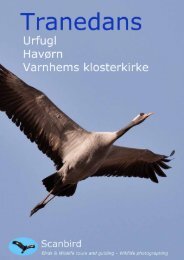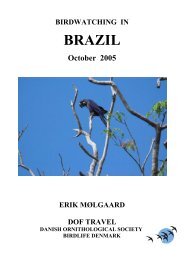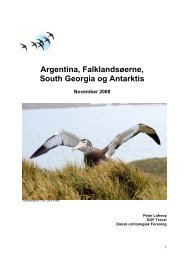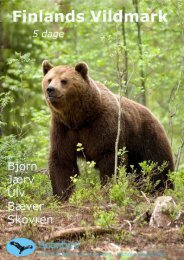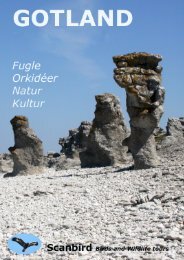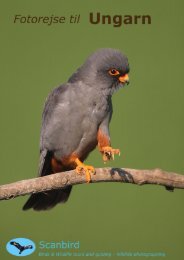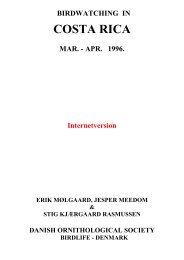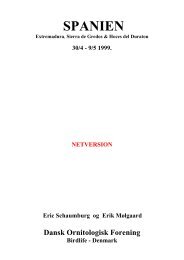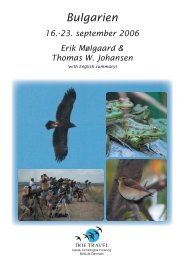Birding Southern Sweden (large PDF file (5 MB) - Tåkerns Fältstation
Birding Southern Sweden (large PDF file (5 MB) - Tåkerns Fältstation
Birding Southern Sweden (large PDF file (5 MB) - Tåkerns Fältstation
Create successful ePaper yourself
Turn your PDF publications into a flip-book with our unique Google optimized e-Paper software.
It is most rewarding to visit the southern Swedish bird lakes<br />
in May. Tåkern has northern Europe’s densest population of<br />
Great Bitterns. The Great Bittern’s muffled booming and the<br />
Great Reed Warblers creaking song makes an impression on your<br />
visit, as does the Bearded Tit’s incessant tinkling from within<br />
the reeds. At Lake Horborga it is perhaps grebes, if anything,<br />
that are the characteristic birds. The lake accommodates <strong>Sweden</strong>’s<br />
<strong>large</strong>st colony of Black-necked Grebes, and with a bit of work<br />
and luck you may see all five of Europe’s grebe species. Hammarsjön<br />
and Araslövssjön in Kristianstad’s Vattenrike accommodate<br />
among other things, breeding Black Terns and Penduline<br />
Tits. The maintained beach meadows are good for waders<br />
and another characteristic bird, the Black-tailed Godwit. Ängsnäset<br />
at Falsterbo peninsula is the last outpost for the rare Kentish<br />
Plover.<br />
May is also the month when many bird watchers go to Öland.<br />
The distinctive landscape there together with special bird life<br />
gives a good chance of seeing southeastern rarities. Among the<br />
local breeding birds there are Thrush Nightingales, Barred Warblers,<br />
Collared Flycatchers, Corncrakes and Montague’s Harriers.<br />
There are also regular rarities such as the Red-rumped Swallow,<br />
Rose-coloured Starling and Marsh Sandpiper. But on Öland<br />
in May anything can appear . . .<br />
A trip to Öland, especially the East Coast, during high and<br />
late summer, can be very rewarding. There are thousands upon<br />
thousands of waders on their way south again after breeding in<br />
the Arctic tundra. Many waders stopover at eastern Öland’s extensive<br />
seaweed banks to feed. For bird watchers it is a rewarding<br />
time. Distances to the birds are often short and you can<br />
comfortably stand and look through the swarming flocks. It is<br />
not at all unusual to be able to see more than 30 species of<br />
waders on eastern Öland’s wader beeches.<br />
In august the autumn migration becomes more obvious over<br />
the whole of southern <strong>Sweden</strong>. Falsterbo, furthest out to the<br />
southwest, is a must for a visit for birdwatchers. At dawn you<br />
can stand out at the furthest point, Nabben, and watch passerines<br />
move southwesterly or watch seabirds and waders leaving<br />
the Baltic Sea. Later on in the morning the birds of prey migration<br />
starts. Towards the end of the month there can be rewarding<br />
days with <strong>large</strong> numbers of Honey Buzzards. A Black Stork<br />
or Lesser-spotted Eagle or other rare bird of prey can enhance<br />
the occasion.<br />
Even as autumn progresses the bird of prey and small bird<br />
migrations are still worthwhile at Falsterbo, but by then it is<br />
Common Buzzards and Sparrowhawks that dominate the birds<br />
of prey and it can even be good for Red Kites. Extremely numerous<br />
among the small birds are the Chaffinches.<br />
A considerably less well-known fine autumn migration is on<br />
offer at the Halland coast and northwestern Scania. When there<br />
is a long lasting easterly wind birds concentrate along the Swedish<br />
West Coast. With such an occasion it is not unusual to be<br />
able to count over half a million migrating finches during a<br />
morning at the southern Halland coast, or that the number of<br />
Common Buzzards there or at the Southwest coast of Scania<br />
can reach 2000. The autumn seabird migration from southern<br />
Hanöbukten, south of Kristianstad is also very good.<br />
In October the bird watcher’s course often leads back to Öland.<br />
It is an exciting time with a taste of the Arctic and Siberia. From<br />
the Arctic come <strong>large</strong> numbers of geese, especially Barnacle Geese<br />
PER MAGNUS ÅHRÉN<br />
MIKAEL NORD<br />
Thousands of Dunlins and other waders are seen in summer.<br />
and Brent Geese who either rest on the beech or migrate past in<br />
long bands. Small passerines e.g. Pallas’s Leaf Warbler, Yellowbrowed<br />
Warbler and Dusky Warbler can be sought, with a little<br />
patience, in the shrubbery along the east beach.<br />
Autumn near to the <strong>large</strong> bird lakes is often worthwhile. Large<br />
numbers of geese and cranes rest there. In flocks of Bean Geese<br />
you can often find all other European geese species such as the<br />
threatened Lesser White-fronted Goose. You can have a good<br />
experience early on an October morning at Lake Tåkern. Thousands<br />
of geese fly right overhead from their night resting places<br />
on the lake to the fields with a red morning sky as a backdrop.<br />
Certain autumns are rewarding along the Swedish West Coast.<br />
Many will surely remember the autumn of 1997 when prolonged<br />
west winds brought sea birds to the coast in numbers never<br />
seen before. It is very singular to experience a fine sea bird day<br />
with Sooty Shearwaters from South America, Sabines’ Gulls from<br />
Canada and Greenland, Pomarine Skuas from Siberia, Fulmars<br />
and Gannets from the north Atlantic bird cliffs and Long-tailed<br />
Skua from the Scandinavian mountains!<br />
Bird areas become quiet in late autumn. But on a still and<br />
clear morning you can hear the first silver bells from the sky –<br />
winter’s first flock of Waxwings drift down and attack a mountain<br />
ash. Perhaps there will be some Pine Grosbeaks in motion<br />
this winter . . .<br />
Pine Grosbeak, a winter visitor.<br />
5



